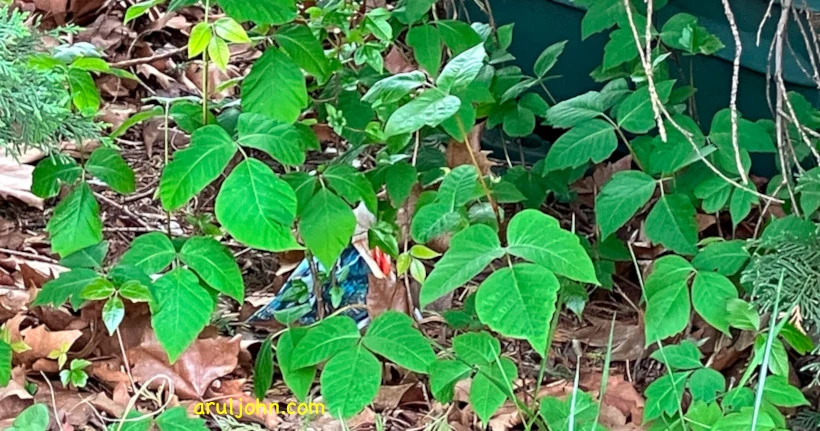
In May 2022, I had a terrible encounter with poison ivy, poison oak and/or poison sumac. At least that's what the Urgent Care doctor told me when my wife rushed me to the hospital at 10pm. This blog post talks about how to identify poison ivy, poison oak, poison sumac, and Virginia creeper, how to avoid these toxic plants and what care to take if touched by them or if you get too close to them.
Table of Contents
- My history with plants and soil
- Introduction
- What does Poison Ivy look like?
- What does Poison Oak look like?
- What does Poison Sumac look like?
- What does Virginia Creeper look like?
- Toxicity levels of Poison Ivy vs Poison Oak vs Poison Sumac
- Where are Poison Ivy, Poison Oak and Poison Sumac found?
- Are all 3-leaf plants Poison Ivy or Poison Oak?
- How do you get in contact with these plants?
- How do you prevent contact with these plants?
- What should you do if Poison Ivy gets on your skin?
- Help! Poison Ivy gave me rashes
- How to get rid of Poison Ivy, Poison Oak and Poison Sumac in your property
- Can I use Roundup?
- Do NOT burn Poison Ivy, Poison Oak and Poison Sumac
- Do I clean my garden tools if they have touched poison ivy?
- Can you get rashes from Poison Ivy in winter?
- Can you get rashes from someone else?
- Can you get rashes from a dog?
- Can you get rashes by touching the person's clothes?
- Can you get rashes by leaning on a fence which had poison ivy?
- Sprays, creams and lotions, and treatment
- When do you see a doctor?
- Apps to identify these plants
- Poison Ivy increase due to climate change
- Photographs in different parts of Virginia
- Conclusion
My history with plants and soil
I love gardening, even though I have been "allergic" to certain plants and soils, and whatever was in them. When I was younger, I ended up in the school clinic and family doctor's clinic quite a few times. In the late 1980s, I had to drop out of gardening class in the 8th grade because digging the soil with my bare fingers caused them to swell. Since then, I have handled soil and different kinds of plants without any problems, but like to be on guard, just in case.
If you are like me and sensitive to certain soils or plants, this blog post may be useful to you.
Introduction
Poison ivy, poison oak, poison sumac, and Virginia creepers are plants that can cause allergic skin reaction by physical contact. The reaction can result in blisters and swelling of the body parts which were in contact with these toxic plants.
Typically, it is the sap or oil within these plants that cause the irritation. While close to 10% of the population is not allergic to most of these plants, they can develop allergy in future if they touch or get in close proximity with them.
Poison ivy, poison oak and poison sumac have sap that contains an oil called urushiol, an oily substance that can stay on clothes and surfaces up to a year or so. In some cases, urushiol can stay on garden tools up to 5 years. This oil is responsible for rashes, itches, swellings, and all the reactions that occur to a human.
This is a diagram of what these three plants look like.
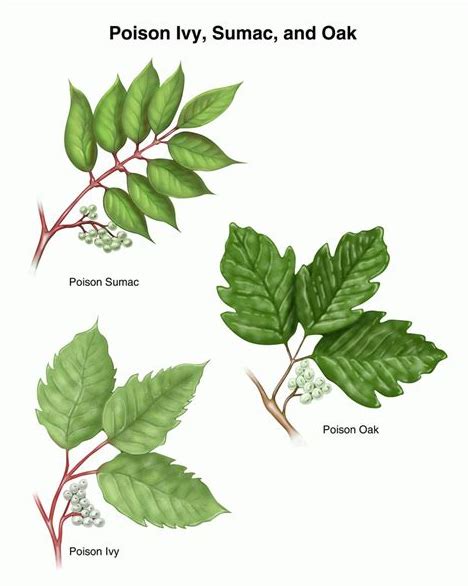 Poison Ivy, Poison Oak, Poison Sumac
Poison Ivy, Poison Oak, Poison Sumac
What does Poison Ivy look like?
There are two types of poison ivy, the eastern poison ivy and western poison ivy. The eastern poison ivy is scientifically known as Toxicodendron radicans and the western poison ivy goes by Toxicodendron rydbergii.
Poison ivy is not a true ivy, but belongs to the cashew family.
Poison ivy plants have pointed leaves that grow in groups of 3. They are usually clustered together. In summer and winter, the leaves are reddish or red and in summer, they are different shades of green. They can also have yellow flowers or greenish berries in summer. Some varieties grow as creepers or climbers, and others grow as clusters of single plants on the ground.
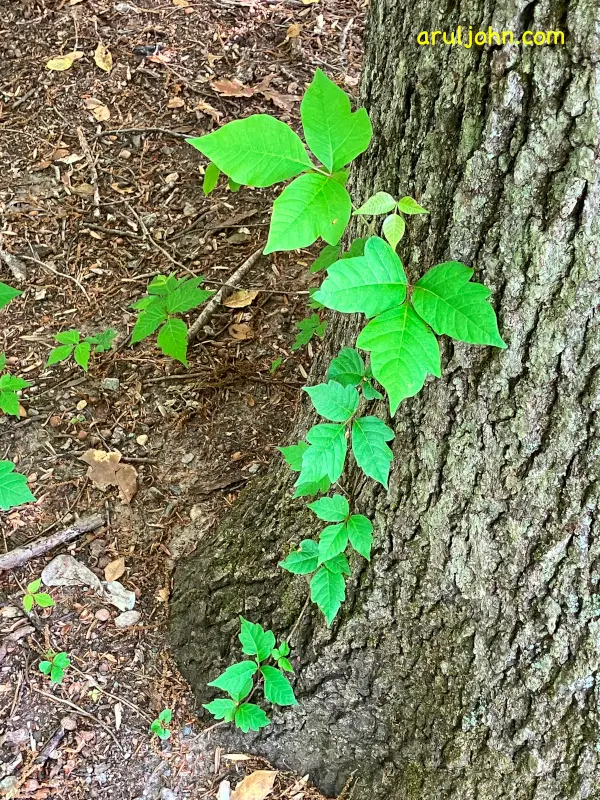 Poison Ivy plant growing as a creeper. Photographed in Lorton, VA
Poison Ivy plant growing as a creeper. Photographed in Lorton, VA
Going by creeper characteristics, there are two types of poison ivy plants, climbing and non-climbing. The climbing type is a vine that goes on fences, walls, branches and bushes. The non-climbing type grows on the ground as multiple small plants or bushes. It is not rare to find both types in one spot. There were several in the woods in Lorton where I took these photos.
In the spring, fall and winter, poison ivy leaves will turn different shades of red. In winter ,they will eventually fall off after turning dark red.
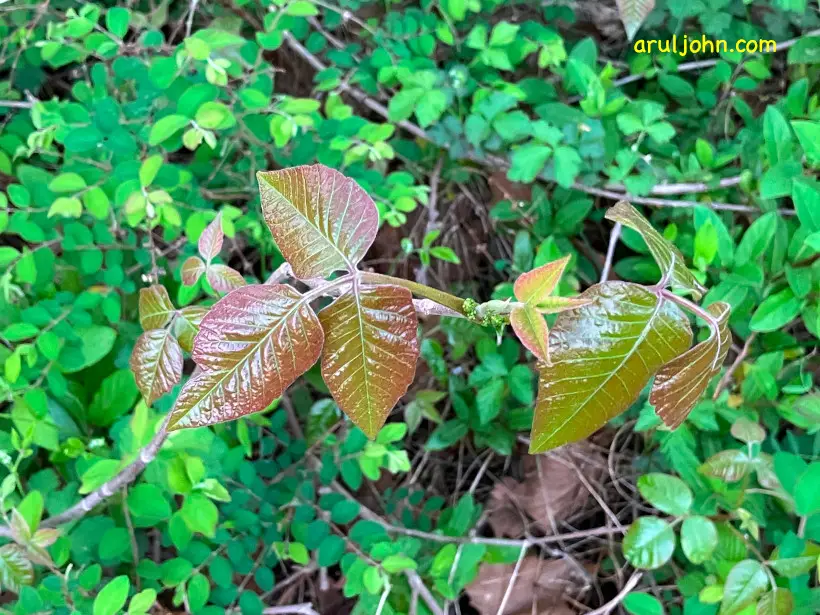 Poison Ivy plant in spring looks reddish. Photo in Shenandoah Farms
Poison Ivy plant in spring looks reddish. Photo in Shenandoah Farms
What does Poison Oak look like?
There are two types of poison oak, the eastern poison oak, also known as Atlantic poison oak, and the western poison oak, also known as Pacific poison oak. The scientific name of eastern poison oak is Toxicodendron pubescens and the scientific name of western poison oak is Toxicodendron diversilobum.
Poison oak plants have leaves similar to oak leaves, but they are not part of the oak family. The leaves are in groups of 3 and are hairy. They are not as bright green as poison ivy.
Similar to poison ivy, the leaves are dull green in summer and reddish brown to dark red in spring and winter. They also grow as creepers or single plant shrubs on the ground.
 Poison Oak plant. Photo probably in Shenandoah Farms
Poison Oak plant. Photo probably in Shenandoah Farms
What does Poison Sumac look like?
Poison sumac is the third dangerous plant in this scary trio. The scientific name is Toxicodendron vernix. This plant grows anywhere from 5 feet up to 30 feet. The leaves are in groups of 7 to 13.
Poison sumac is more dangerous than poison ivy and poison oak.
What does Virginia Creeper look like?
Virginia creeper is also known as five-leaved ivy, or woodbine. Scientifically, it is called as Parthenocissus quinquefolia. It belongs to the grape family.
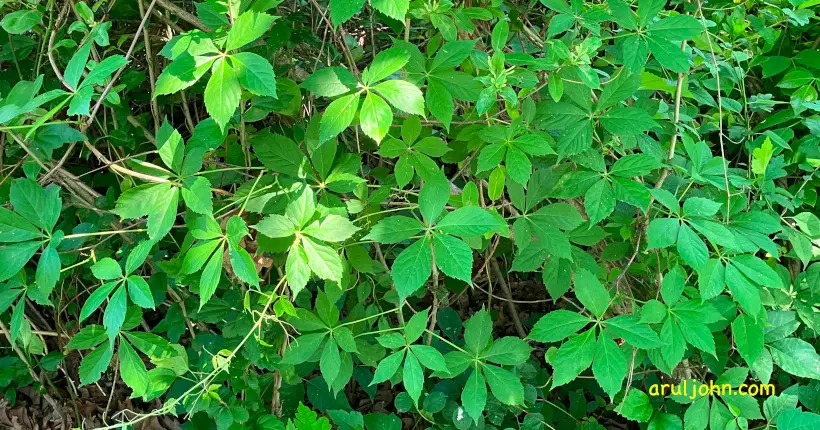 Virginia Creeper. Photo in Lorton, VA
Virginia Creeper. Photo in Lorton, VA
This plant can grow up to 100 feet. The leaves are in groups of 5 and quite distinct. You may find them in your backyard. I actually found one growing between the floorboards in my deck! Another time, I saw this Virginia creeper growing on a fence.
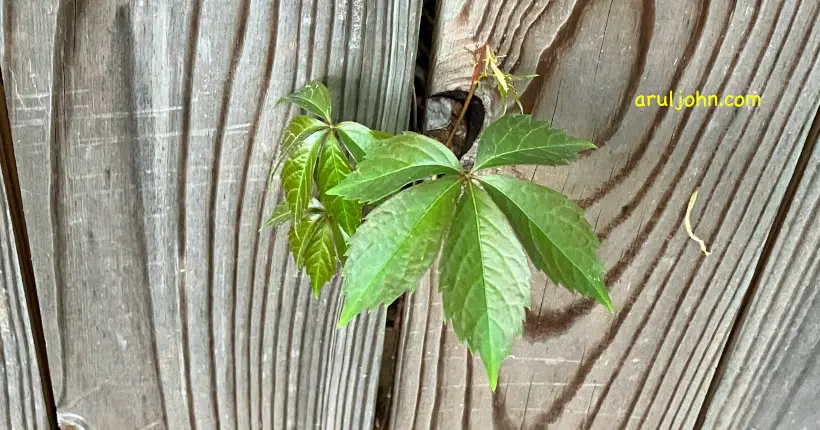 Virginia Creeper plant in spring. Photo in Chantilly, VA
Virginia Creeper plant in spring. Photo in Chantilly, VA
Okay, so what's the deal with Virginia creeper? It does not have urishiol, which is good news. However, the leaves and stem contain sap which have raphides -- needle shaped crystals -- that can puncture the skin and cause irritation and blisters in certain people. Raphides are toxic and the symptoms include numbing followed by stinging and rashes. Some people are more allergic to Virginia creepers than poison ivy and poison oak, and suffer for a longer time.
Toxicity levels of Poison Ivy vs Poison Oak vs Poison Sumac
Poison sumac has a C13 side chain while poison oak has a C17 side chain and poison ivy has a C15 side chain. Poison sumac is the most toxic among these three.
Where are Poison Ivy, Poison Oak and Poison Sumac found?
Geographically, poison ivy (Eastern) is found in most of easter North America and Asia. Poison ivy (Western) is found in most of the states in the USA and Canada.
In nature, poison ivy is found in wooded areas, trails, yards, and grows as weeds. If you live in a suburban area, you may notice poison ivy plants while taking a walk in a trail or mowing your lawn.
Sometimes, poison oak is found in areas where poison ivy is found. But in general, most Pacific poison oak plants are found on the US west coast, while most Atlantic poison oak plants are found on the US east coast.
Poison sumac is found mostly in the eastern part of the US, but you do find them all over the Americas, including Canada.
Some people thought it's a good idea to export these plants to other countries, so you find these in a few Asian countries as well.
Are all 3-leaf plants Poison Ivy or Poison Oak?
No. If you have heard of the phrase, "leaves of three, let it be", that is a misleading phrase. There are many 3-leaf plants that we have in our backyard, that are completely safe. A few examples are wild strawberry, dewberry, and fragrant sumac and regular oak.
To be on the safe side, please use an app or err on the side of caution while handling these plants.
How do you get in contact with these plants?
Physical contact while walking on trails or accidentally touching the poison ivy plants in yards are the most common ways of getting poison ivy.
If you have pets and they have rubbed against poison ivy, and they rub against you, you're contaminated! One man walking on a trail stopped to pet a dog, and then continued on his way to the restroom. Turns out the dog's fur had poison ivy, and the poor man suffered with poison ivy rashes for the next few months.
If you like to hug and rub your hands on dogs or cats, wash them, especially when you're in the woods. Animals are immune to poison ivy, poison oak and poison sumac.
Another way you can get in contact with these plants is camping /campsites. I took my kids for Dad and Kids camp, and in our campsite, saw dozens of poison ivy plants all over the place. Nothing happened, but I had to be on guard all the time.
How do you prevent contact with these plants?
Wear long sleeve clothes and full length pants when working in an area with poison ivy. Make sure you have socks and boots as well.
After you are done, throw your clothes and socks into the washing machine. Just to be on the safe side, wash the area around your ankle with Dawn liquid soap or bath soap.
I still have scars around my ankle area as a reminder, so my spider senses kick in when I am going for a walk or jog.
What should you do if Poison Ivy gets on your skin?
First of all, do not panic. Even if you are fully covered, there is a chance of getting poison ivy or urushiol oil on your skin.
There are several ways of handling poison ivy that you or your shoes or clothes accidentally touched.
Dawn liquid soap or laundry detergent
Think of poison ivy as car grease. You can break it down with liquid dishwashing soap. Dawn is one of the best because it breaks down the oils and washes off the toxic oil.
Wash the area first and then apply a mix of water and liquid soap, or water and laundry detergent. Wash it off well. This will remove the greasy residue.
Rubbing alcohol or hand sanitizer
Another solution is to apply rubbing alcohol on the exposed part of your skin. Whenever I dig out a poison ivy plant, at the end of the whole process, I wash my hands with a little 70% isopropyl alcohol.
I also use Purell hand sanitizer with 70% alcohol. These are occasionally sold at discount in Target, Walmart or other stores.
Help! I have Poison Ivy on my face or neck
Wash the area gently with Dawn liquid soap, and just to be on the safe side, go to your doctor immediately. Poison ivy that gets into the airways or your face can harm your respiratory system or worse.
Help! Poison Ivy gave me rashes
Follow these steps.
- Wash the affected area with Dawn soap and water as soon as possible to remove any remaining plant sap / urushiol.
- Apply a cold compress or take a cool bath to help with the itching, swelling and inflammation.
- Use calamine lotion, hydrocortisone cream or Zanfel to help reduce itching and dry up the rash. All of these are over-the-counter products.
- Take Benadryl or an antihistamine to help relieve itching and reduce swelling.
- Avoid scratching the rash, as this can lead to infection.
- If the rash is severe or covers a large area of your body, see a doctor immediately. I was prescribed steroids.
Poison ivy rashes can take several days or even weeks to go away completely, so be patient and continue to treat the symptoms until the rash clears up. Mine took about 2 months to go away. I have the scars left though; they are permanent.
How to get rid of Poison Ivy, Poison Oak and Poison Sumac in your property
If you find these toxic plants in your property, do try to get rid of them at the earliest. There are many ways to get rid of these plants.
Dig out the Poison Ivy completely (most effective)
This is the most effective way, and I do this whenever I see a little poison ivy plant (or poison oak or poison sumac).
The roots grow very fast, deep and wide, so the earlier you dig them out, the better.
First, wear a full sleeves shirt and full length trousers. If possible, wear a face mask as well. Wear rubber gloves that you will dispose of later.
Using a shovel, draw a radius of 12 inches around the plant and dig out the plant with the soil. This should ensure that the plant is removed completely, roots included. Poison ivy has long and deep roots, and even the roots have urushiol, so you want to get rid of them as well.
With the same shovel, put the plant with roots in an Amazon box or yard paper bag and dispose safely.
Smother them with flattened cardboard boxes or any opaque plastic cover
This may or may not work depending on how much they have propagated.
Flatten as many cardboard boxes as you can, or just use an opaque plastic cover or tarp. Cover the poison ivy with this. Doing this blocks out light and oxygen and the plant eventually dies after being starved. This may take a week or two to work.
After a week or two, if the plant turns brown or dry, dig around the plant and pull it out. Make sure you are wearing full length clothing and have no part of your body exposed.
Pour boiling water over Poison Ivy (least effective)
You can also pour boiling water on the plants. It drowns the roots. Unfortunately, this did not work for me all the time.
You can hire goats to get rid of Poison Ivy in your yard
🐐 Yes, there are business that allow you to rent goats that eat up poison ivy in your yard. Animals are not affected by these plants, and goats will happily graze on them.
Make sure you contact your HOA if your HOA is strict about things like this. Usually, urban HOAs can penalize you if you bring goats on your property without prior permission.
Can I use Roundup?
Short answer: NO 🙅♀️
Long answer: I used Roundup weedkiller a couple of times before reading up on the cancer lawsuit.
I sprayed Roundup weedkiller on the leaves and branches of a poison ivy vine in my backyard. The leaves continued to be green for several days following that. I sprayed again and then after 4 or 5 days, the leaves turned brown and died. Roundup was very slow to work.
After that, I read the lawsuit on Roundup and disposed of it.
Do NOT burn Poison Ivy, Poison Oak and Poison Sumac
🔥 Remember that you should NOT burn poison ivy! Ever! Burning these plants can irritate the nasal passage, oral cavity and lungs. The urushiol oil will be airborne and cause internal damage and an allergic respiratory reaction.
Just to be on the same side, wear a mask while dealing with burning plants. This is to avoid the possibility of including poison ivy, poison oak or poison sumac in the mix.
It is not even safe to burn wood that may have poison ivy dried vine around it.
NOTE: It is also illegal to burn poison ivy, poison oak and poison sumac in many states.
If you accidentally burn poison ivy, oak or sumac and inhale smoke, rush to the doctor's immediately.
Do I clean my garden tools if they have touched poison ivy?
⚒️ Yes, definitely do that! If you cut the roots or plant with your shovel, the shovel would have urishiol on them for years, sometimes up to 5 years.
Sanitize using Isopropyl alcohol
Isopropyl alcohol, also known as rubbing alcohol, is the best for cleaning the shovel. Just pour a little on the shovel blade and with an old cloth, gently wipe it off. Dispose of the cloth safely. I use this all the time, with 70% isopropyl alcohol from Walmart.
Sanitize using bleach
In the absence of isopropyl alcohol, create a solution with 1 tablespoon of bleach and 1 gallon of water. Wash the blade of the shovel slowly, making sure the solution has reached every part of the shovel blade.
Do this at a place where you will not expect to grow plants in the near future.
Sanitize using Dawn soap solution
A third method is by using Dawn soap solution.
Fill a container with hot water. Add Dawn soap to it and stir well. I get my Dawn soap
Remember to dispose off the rubber gloves and the bag or box containing the poison ivy, and sanitize your shoes/boots as well.
Can you get rashes from Poison Ivy in winter?
Yes, even the leaves may not be there, the roots and alive and contain urishiol. Touch the roots and that can cause a rash.
Can you get rashes from someone else?
No, rashes caused by poison ivy are not contagious. However, if you touch the person's skin and there are traces of urishiol, you have just shared the toxin on yourself.
Can you get rashes from a dog?
Yes, as mentioned above, dogs and cats can rub against poison ivy and thereby get urushiol on their fur. Touch the fur, and you have urishiol on yourself, which will be followed by rashes in a day or two.
Can you get rashes by touching the person's clothes?
Yes, if the clothes have not been washed yet and still contain urishiol, you get it on you.
To avoid this from happening, as soon as you reach home, throw the clothes in the washing machine and wash on HOT setting with a decent amount of laundry detergent. The laundry detergent will break down the urushiol and get wash it away from the clothes.
Can you get rashes by leaning on a fence which had poison ivy?
Yes, if there was a poison ivy plant or remnant of the vine on it, the urushiol might still be active. Sanitize the fence with bleach or alcohol before putting your hand or sitting on it.
Sprays, creams and lotions, and treatment
🧴 I used Calamine lotion on my rashes everyday for a few weeks. My wife also got a bottle of Poison Ivy/Oak 2oz spray. This spray is supposed to dry the rash. Hydrocortisone creams are good for quick relief and comfort.
Zanfel is a newer product that sucks the plant oil out of the skin very fast. Consult a doctor first before using this.
There are other over-the-counter medications you can take, usually externally. Benadryl is used to sleep better, though I have not used it.
My doctor also prescribed steroids for 3 weeks, and hopefully you will not have to take it.
When do you see a doctor?
When your body part that is in contact with the urushiol has swollen or you are finding it hard to breathe, that's when you get someone to drive you to the ER or Urgent Care. Most people do not need to see a doctor for ivy reaction. Unfortunately, some do.
If the rashes are too many or cover a wide area of your skin, visit your doctor. If you get a fever (over 100F), visit your doctor immediately.
Apps to identify these plants
PlanetNet is a great app that I have used since my encounter with poison ivy.
Download the app. Take a clear photo of the plant and and upload it by going to Identification → Gallery → (select the photo) and (select Leaf). The app will show you the name of the leaf and other information.
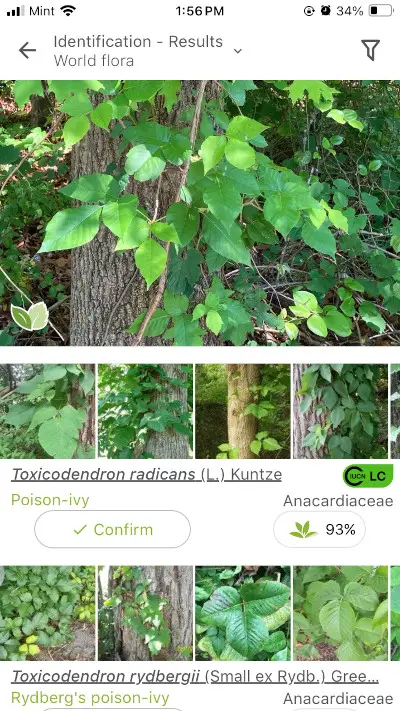 PlanetNet App
PlanetNet App
Poison Ivy increase due to climate change
Poison ivy has increased in number due to increase in general carbon dioxide levels and warmer temperatures.
At Duke University, Dr. William Schlesinger and his team observed a forest laboratory for years. They pumped carbon dioxide around a circular forest plot to observe climate change and its effects in the 1990s. They found that everything grew faster with extra CO2. However, poison ivy grew the fastest, growing 70% faster even withough the extra CO2. The poison ivy leaves got bigger as well. The vine roots loved the warmth and spread more and wide.
Photographs in different parts of Virginia
The photos in this blog post were taken in my Virginia neighborhood, the woods in Shenandoah Farms, Lorton, VA and along trails in Virginia.
Conclusion
This blog post just summarizes my new found interest in toxic plants, particularly in the eastern coast part of the US. This is not a research blog or one for medical advice. Whatever is in here is what I experienced, observed and continue to observe.
I am allergic to certain plants and soil, and I have no idea what other plants will affect me. However, this may not be the case with you.
And if you are currently not allergic to poison ivy, this does not mean this exemption will continue forever. People can get allergic to objects later in life; it has happened to family and friends.
Please treat poisonous plants with extra care. Thanks for reading!
Related Posts
If you have any questions, please contact me at arulbOsutkNiqlzziyties@gNqmaizl.bkcom. You can also post questions in our Facebook group. Thank you.